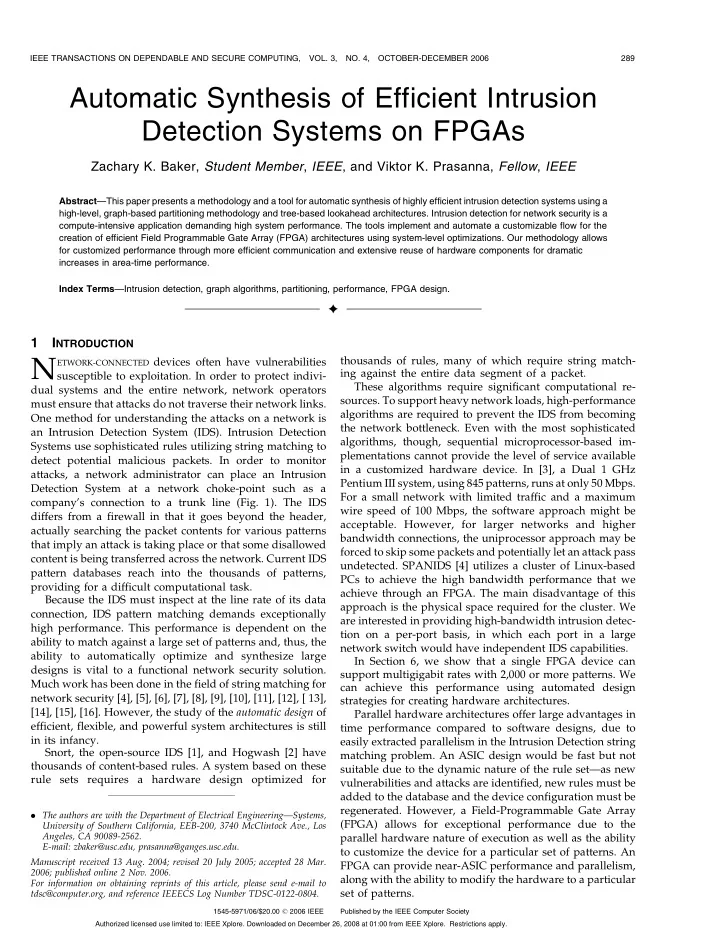

IEEE TRANSACTIONS ON DEPENDABLE AND SECURE COMPUTING, VOL. 3, NO. 4, OCTOBER-DECEMBER 2006 289 Automatic Synthesis of Efficient Intrusion Detection Systems on FPGAs Zachary K. Baker, Student Member , IEEE , and Viktor K. Prasanna, Fellow , IEEE Abstract —This paper presents a methodology and a tool for automatic synthesis of highly efficient intrusion detection systems using a high-level, graph-based partitioning methodology and tree-based lookahead architectures. Intrusion detection for network security is a compute-intensive application demanding high system performance. The tools implement and automate a customizable flow for the creation of efficient Field Programmable Gate Array (FPGA) architectures using system-level optimizations. Our methodology allows for customized performance through more efficient communication and extensive reuse of hardware components for dramatic increases in area-time performance. Index Terms —Intrusion detection, graph algorithms, partitioning, performance, FPGA design. Ç 1 I NTRODUCTION thousands of rules, many of which require string match- N ETWORK-CONNECTED devices often have vulnerabilities ing against the entire data segment of a packet. susceptible to exploitation. In order to protect indivi- These algorithms require significant computational re- dual systems and the entire network, network operators sources. To support heavy network loads, high-performance must ensure that attacks do not traverse their network links. algorithms are required to prevent the IDS from becoming One method for understanding the attacks on a network is the network bottleneck. Even with the most sophisticated an Intrusion Detection System (IDS). Intrusion Detection algorithms, though, sequential microprocessor-based im- Systems use sophisticated rules utilizing string matching to plementations cannot provide the level of service available detect potential malicious packets. In order to monitor in a customized hardware device. In [3], a Dual 1 GHz attacks, a network administrator can place an Intrusion Pentium III system, using 845 patterns, runs at only 50 Mbps. Detection System at a network choke-point such as a For a small network with limited traffic and a maximum company’s connection to a trunk line (Fig. 1). The IDS wire speed of 100 Mbps, the software approach might be differs from a firewall in that it goes beyond the header, acceptable. However, for larger networks and higher actually searching the packet contents for various patterns bandwidth connections, the uniprocessor approach may be that imply an attack is taking place or that some disallowed forced to skip some packets and potentially let an attack pass content is being transferred across the network. Current IDS undetected. SPANIDS [4] utilizes a cluster of Linux-based pattern databases reach into the thousands of patterns, PCs to achieve the high bandwidth performance that we providing for a difficult computational task. achieve through an FPGA. The main disadvantage of this Because the IDS must inspect at the line rate of its data approach is the physical space required for the cluster. We connection, IDS pattern matching demands exceptionally are interested in providing high-bandwidth intrusion detec- high performance. This performance is dependent on the tion on a per-port basis, in which each port in a large ability to match against a large set of patterns and, thus, the network switch would have independent IDS capabilities. ability to automatically optimize and synthesize large In Section 6, we show that a single FPGA device can designs is vital to a functional network security solution. support multigigabit rates with 2,000 or more patterns. We Much work has been done in the field of string matching for can achieve this performance using automated design network security [4], [5], [6], [7], [8], [9], [10], [11], [12], [ 13], strategies for creating hardware architectures. [14], [15], [16]. However, the study of the automatic design of Parallel hardware architectures offer large advantages in efficient, flexible, and powerful system architectures is still time performance compared to software designs, due to in its infancy. easily extracted parallelism in the Intrusion Detection string Snort, the open-source IDS [1], and Hogwash [2] have matching problem. An ASIC design would be fast but not thousands of content-based rules. A system based on these suitable due to the dynamic nature of the rule set—as new rule sets requires a hardware design optimized for vulnerabilities and attacks are identified, new rules must be added to the database and the device configuration must be regenerated. However, a Field-Programmable Gate Array . The authors are with the Department of Electrical Engineering—Systems, (FPGA) allows for exceptional performance due to the University of Southern California, EEB-200, 3740 McClintock Ave., Los Angeles, CA 90089-2562. parallel hardware nature of execution as well as the ability E-mail: zbaker@usc.edu, prasanna@ganges.usc.edu. to customize the device for a particular set of patterns. An Manuscript received 13 Aug. 2004; revised 20 July 2005; accepted 28 Mar. FPGA can provide near-ASIC performance and parallelism, 2006; published online 2 Nov. 2006. along with the ability to modify the hardware to a particular For information on obtaining reprints of this article, please send e-mail to set of patterns. tdsc@computer.org, and reference IEEECS Log Number TDSC-0122-0804. 1545-5971/06/$20.00 � 2006 IEEE Published by the IEEE Computer Society Authorized licensed use limited to: IEEE Xplore. Downloaded on December 26, 2008 at 01:00 from IEEE Xplore. Restrictions apply.
Recommend
More recommend